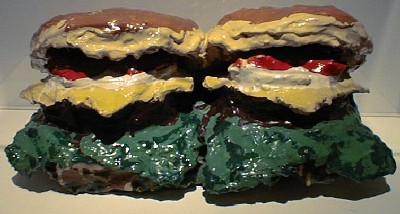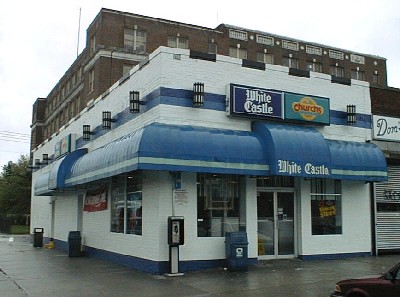White Tower
Today, thoughts about an architecture for hard times. The University of Houston's College of Engineering presents this series about the machines that make our civilization run, and the people whose ingenuity created them.
"Where shall we eat?" my wife asked when she picked me up this evening. We ran through our usual set of fast food shops. None was right. Finally, with the unspoken agreement of two lemmings, we headed for an upscale hamburger emporium. That made no sense. We seldom eat hamburgers.
Well, maybe it did make sense. I'd just found a book on the history of the White Tower chain. We'd looked at it before we drove away. And if you're old enough, you know what that meant.
The old White Castle, White Tower chains served up five-cent hamburgers while we grew up in the 1930s. Sunday evenings, my father would pick up a bag of White Castle hamburgers. They were small, fried in sizzling grease and onions, garnished with pickle slices. We'd eat them and listen to Jack Benny on the radio.
The White Castle chain was founded in Wichita in 1921. The White Tower Chain started out in Milwaukee five years later.
They were exercises in minimalism. A small, radiant white building with a medieval tower for an entrance. Gleaming chrome and white tile inside. A narrow menu. White Tower offered hamburgers, coffee, ham sandwiches, pie, donuts, and soda pop. Mustard but no ketchup. It was all served on paper napkins.
Those tiny buildings spoke the architectural kitsch of the '20s -- a slightly exotic medieval theme -- simple eye-catching glitz to draw in the new automobile trade. But if they were creatures of the '20s boom, they had two qualities that gave them staying power for the Depression years of my childhood.
One was Spartan simplicity. They were the least means for feeding people who had only a nickel. The other feature was that dreamy veneer of medieval fantasy. A place to escape the hard reality of hunger that was all around. If you saw the Susan Sarandon movie, White Palace, that dreamlike simplicity was now gone -- lost in a post-modern version of the White Castle.
As money and hope evaporated in the '30s, the two chains built and expanded. Cheap food and cheap entertainment are commodities that survive in the worst of times. Fifteen-cent movies, five-cent hamburgers, and Jack Benny on the radio -- that was the stuff of my childhood, back in America's hardest days.
Now my wife and I, drawn by those primal memories, eat our large, thick, post-modern hamburgers with side servings of garlic couscous. We pay 120 times what we once paid the White Castle.
We eat and talk about that sweet impoverished world between two wars -- about wonderful five-cent pleasures in kitschy little fairy-tale diners. It has become hard to believe that all that was only the technology of getting by -- in the worst of times.
I'm John Lienhard, at the University of Houston, where we're interested in the way inventive minds work.
(Theme music)
Hirshorn, P., and Izenour, S., White Towers. Cambridge, Mass.: MIT Press, 1979.

Photo of a sculpture at the New York Museum of Modern Art
Artist's version of a modern hamburger

Photo by John Lienhard
Actually, the White Castle chain still exists. This shop, in Astoria, New York, was still selling a small 49-cent hamburger in 1997, although it did not have quite the same look about it.